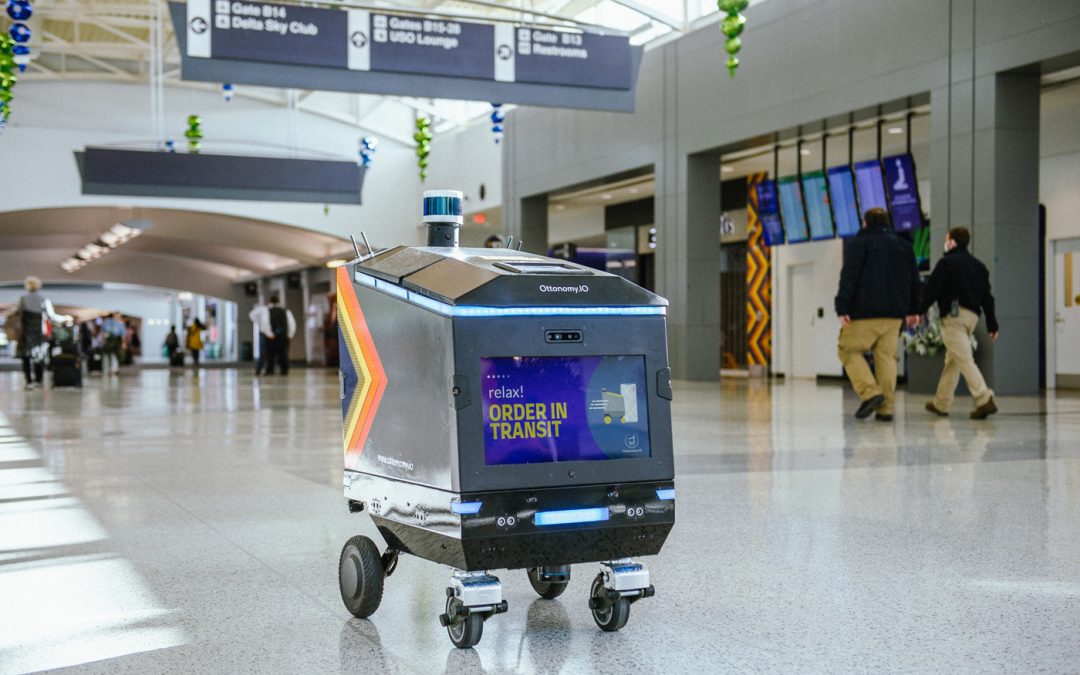Ottonomy is approaching robotic delivery with a mind toward scaling where it can operate now as the broader robotic delivery industry matures.
CEO Ritukar Vijay has a deep background in robotics, working for nearly 14 years on unmanned aerial drones, warehouse logistics robots and robotic vehicles as well. He said he and his fellow cofounders were working on autonomous cars when he realized the promise of driverless cars was still far off.
“We came to the realization that autonomous cars will take some time to hit Main Street,” said Vijay. “So it was, how can we turn our experience into solving the experience of today? That’s how we came to the delivery space.”
The first move was to understand the gaps in the robotic delivery space. In early 2020, there were robots rolling down some sidewalks, companies were developing a saturation on campuses and a handful of companies were being funded to take on citywide logistics. Few robots, however, were going in and out of buildings or tackling spaces like airports or large facilities.
“If you think about door-to-door delivery retail, that’s a minimal use case,” said Vijay. “That doesn’t resonate or connect with the large corporate population where these [robots] can get inside the facility. They need to be inside the facility or store itself.”
There were some tweaks to the typical robot outlay too. He didn’t like camera-only robots, they work OK in controlled environments but the vast majority of the world is not a controlled campus environment. His thinking aligns with the stages of automation, 0 being no automation and level 5 being complete automation in any environment. He said his tweaks get Ottonomy to level 3 and help the bots navigate real-world weather.
“Most players are at stage two and realizing that being truly autonomous will make the whole business move and the unit economics work,” said Vijay. “Stage three is of great importance, it can pretty much work for years to come if you can navigate in snow or drizzly rain.”
With a different approach in mind, Vijay and his team launched in 2020 and within months were running bots around the Cincinnati airport and going in and out of retailers to take over curbside delivery. The latter was a perfect fit for the mass pivot to no-contact orders.
“You order online, park your car in the designated spot and your robot will get your order from inside the store to you. This is something which is helpful that we can achieve because we can navigate indoors and outdoors,” said Vijay.
Curbside, he said, is a foundational move for the company as it seeks to scale nationally. Major retailers are happy to bring in a bot to shed the tedious job of walking out to the parking lot over and over, and they aren’t bound by regulatory limitations around robotics.
“The curbside delivery form inside to outside is scalable across the country it’s not bound by regulations, a lot of places have regulations around sidewalk robotics, so a large countrywide player still cannot scale,” said Vijay. “Our approach is to scale with partners nationwide then scale further from store curbside to store to doorstep.”
He said curbside robotic delivery saves close to 60 percent compared to typical staffing. The pricing is still coming into view, but he said at $2,000 a month per location meets that savings level and helps retailers deliver to cars at all hours of the day.
As for his airport operations, he said things are growing along with travel, but it has been an important training ground for a core competency of the company which Vijay calls “contextual mobility.”
“Navigating the environment is one of the most important things in airports. We have something called contextual mobility, which understand the context of the environment. The robot plans 100 to 800 trajectories to reach the goal point. At all points, the robot is monitoring the behavior of other people,” said Vijay.
Walk through an airport and you’ll see people laying on the floor, taking a sharp turn to a bathroom or simply not watching where they’re walking. Vijay and his team had to equip the bot to think through any potentiality in that airport. If a bot can’t find a route, it disengages and hands control to a human driver.
“We’ve had zero disengagements in the airport. I’ll give some credit to less traffic during COVID, but we handled it through Thanksgiving travel season as well,” said Vijay.
Ottonomy secured a $1.2 million pre-seed round in early December of this year, money that will help fuel scale and new curbside partnerships. He said the company is also working on a sidewalk bot that will work well in dense urban environments where contextual mobility and weather resistance is key, that segment of the business will expand as the rules around sidewalk delivery become more friendly.


